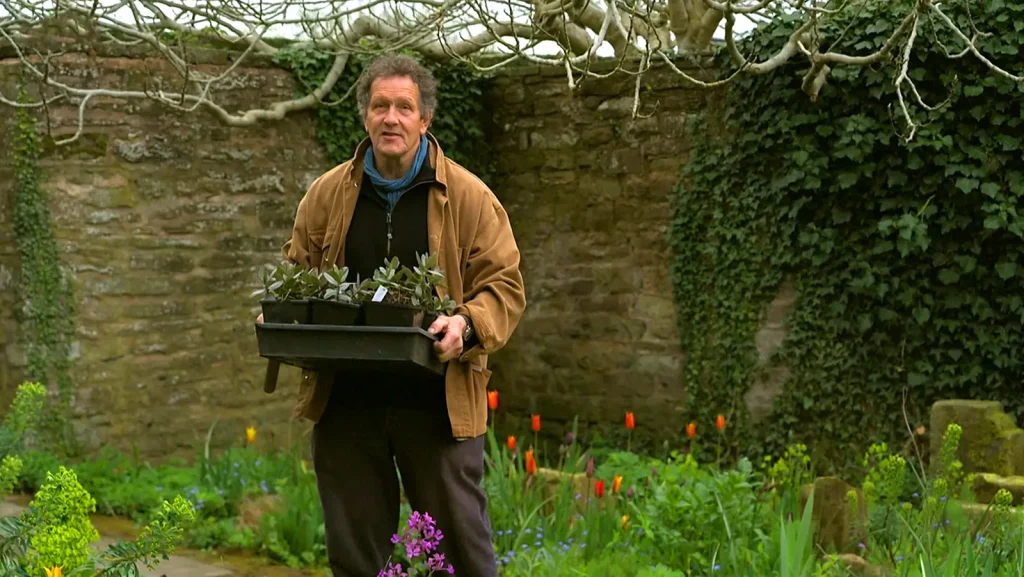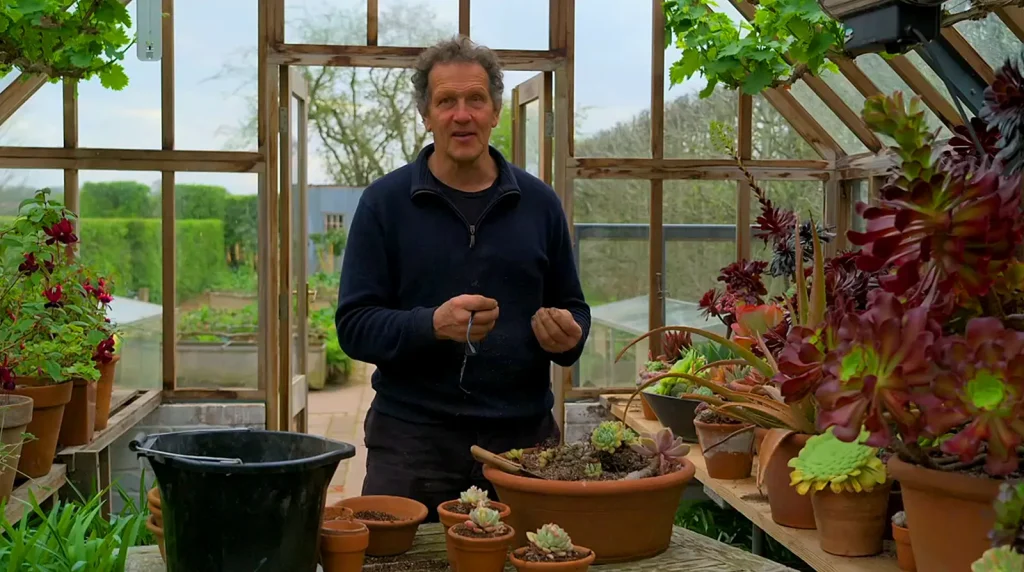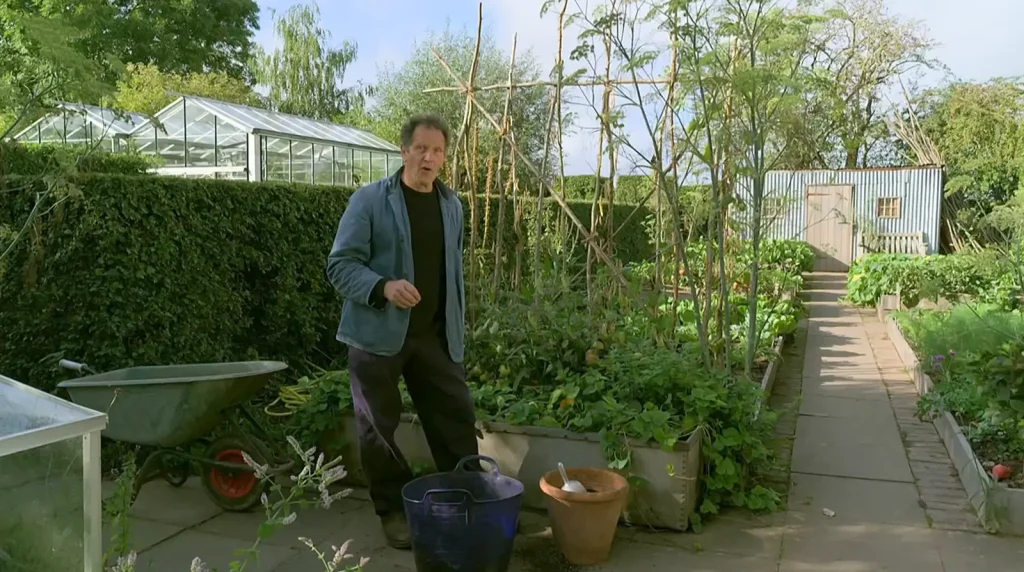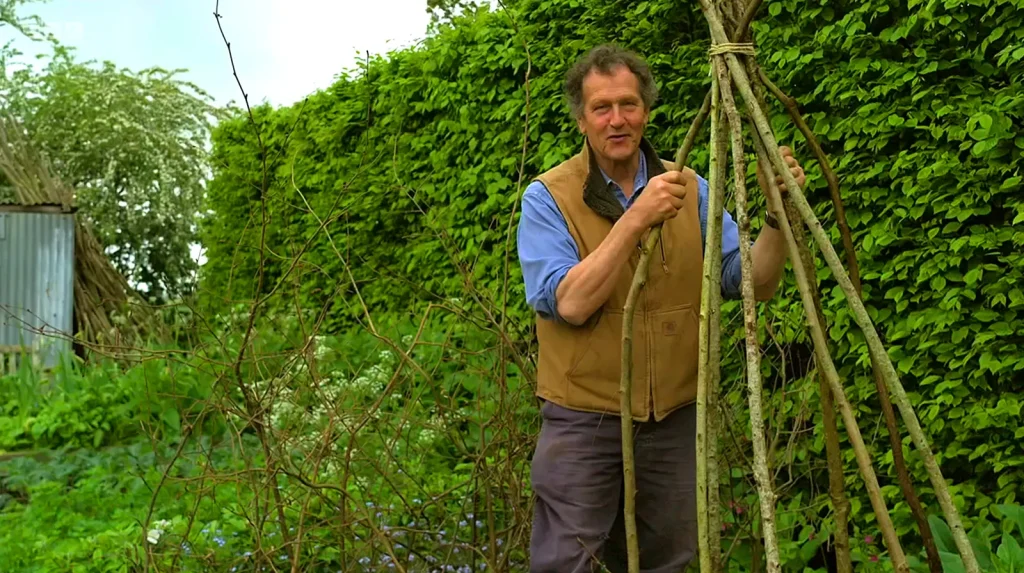Gardeners World 2024 Episode 4 – Spring has arrived, and the gardens are awakening from their winter slumber. As the days grow longer and warmer, Adam Frost takes stock of his borders, carefully assessing the existing plants and planning for a year-round display of color and texture. With a keen eye for design, he thoughtfully considers the addition of new elements to create a harmonious and ever-changing tapestry of blooms. In the midst of this horticultural renaissance, Adam turns his attention to his vegetable garden, where he incorporates soft fruit bushes and trees, a delightful fusion of edible and ornamental delights. The promise of succulent berries and tangy fruits adds an enticing layer to the garden’s bounty.
While Adam embraces the changing seasons in his own green oasis, Joe Swift embarks on a journey to Birmingham, where he meets an allotmenteer whose passion knows no bounds. This green-thumbed enthusiast has dedicated their plot to cultivating the flavors and aromas of Italy, with a tapestry of tomatoes, herbs, and vibrant vegetables that transport the senses to the sun-drenched landscapes of the Mediterranean.
Across the country, in the charming county of East Sussex, Arit Anderson finds herself immersed in the artistic brilliance of Charleston, a garden designed as a living canvas by the visionary artist Vanessa Bell. Here, nature and art converge in a symphony of colors, textures, and forms, inviting visitors to experience the world through the artist’s lens.
In the rolling hills of West Yorkshire, a couple defies the challenges posed by slugs and snails, nurturing a remarkable collection of hundreds of hosta varieties in their garden. With unwavering determination and a deep appreciation for these versatile and architectural plants, they have crafted a verdant oasis that showcases the beauty and resilience of nature.
Not far away, a young head gardener in his mid-twenties juggles the management of not one, but two, arts and crafts-inspired gardens in Somerset. With a passion that belies his youth, he skillfully orchestrates the harmonious blend of architecture and horticulture, weaving together the elements of design and nature to create a living masterpiece.
As the episode unfolds, viewers are treated to a kaleidoscope of gardening stories, each one a testament to the enduring allure of the natural world. From the meticulous planning of Adam Frost’s borders to the exuberant embrace of Italian flavors in Birmingham, from the artistic vision of Charleston to the tenacious cultivation of hostas in West Yorkshire, and the youthful energy of the Somerset head gardener, “Gardeners’ World 2024 Episode 4” celebrates the diversity and beauty of gardening in all its forms.
Gardeners World 2024 Episode 4
Maximizing Beauty in Shaded Gardens: The Art of Shade Planting with Shrubs
Shaded gardens, often seen as a landscaping challenge, hold the potential for creating stunningly beautiful and serene spaces. With the right choice of shade-tolerant shrubs, gardeners can transform these cool, shadowy areas into vibrant, lush oases. This article explores how to make the most of shaded gardens through the art of shade planting with shrubs, offering insights and advice for both novice and experienced gardeners.
Understanding Shade in the Garden
Types of Shade
Shade in gardens can vary significantly, from the dappled light beneath a tree canopy to the deep shade cast by buildings. Recognizing the type of shade you have is crucial for selecting plants that will thrive in your garden.
Benefits of Shade-Tolerant Shrubs
Shade-tolerant shrubs are not just survivors in low-light conditions; they offer a range of benefits, including adding structure to your garden, providing year-round interest, and creating habitats for wildlife. These plants can flourish where others struggle, bringing life and color to otherwise overlooked spaces.
Selecting Shrubs for Shaded Gardens
Top Picks for Robust Shade-Tolerant Shrubs
Several shrubs are known for their resilience and beauty in shaded areas. Favorites include:
- Lonicera nitida ‘Baggesen’s Gold’ for its vibrant foliage,
- Mahonia oiwakensis subsp. lomariifolia for striking winter flowers,
- Prunus laurocerasus ‘Otto Luyken’ for glossy green leaves and spring blooms,
- Sarcococca hookeriana var. humilis for fragrance and compact growth,
- Viburnum × hilleri ‘Winton’ for its scented flowers, and
- Vinca minor ‘Atropurpurea’ for ground cover with purple blooms.
Shrubs for Deep Shade
For the deepest, darkest corners of your garden, consider:
- Aucuba japonica ‘Crotonifolia’, known for its speckled leaves and bright berries,
- Camellia sasanqua ‘Jean May’, which blooms beautifully in winter,
- Fatsia japonica, offering dramatic foliage and architectural interest.
Shrubs for Partial or Dappled Shade
In areas with filtered light, try:
- Arbutus unedo ‘Elfin King’ for its attractive bark and autumn fruits,
- Azara microphylla, which delights with tiny, fragrant winter flowers,
- Choisya ternata, offering lush foliage and aromatic blooms.
Planting and Care Tips
To ensure your shade-tolerant shrubs thrive, consider the following tips:
- Soil Preparation: Amend the soil with organic matter to improve fertility and drainage.
- Watering: Newly planted shrubs require consistent moisture, especially in dry shaded areas.
- Mulching: Apply a layer of mulch to retain soil moisture and suppress weeds.
- Pruning: Regular pruning keeps shrubs healthy and promotes vigorous growth.
The Ultimate Guide to Growing Raspberries: Expert Tips for Bountiful Harvests
Growing raspberries is a rewarding endeavor for any gardener looking to enjoy fresh, juicy berries from their own backyard. Raspberries, with their rich flavor and nutritional benefits, are versatile fruits that can be grown in a variety of settings, from spacious gardens to compact containers. This guide will provide you with expert advice on how to cultivate raspberries successfully, ensuring a bountiful harvest year after year.
Choosing the Right Varieties
Summer-Fruiting vs. Autumn-Fruiting Raspberries
Raspberries come in two main types: summer-fruiting and autumn-fruiting. Summer-fruiting raspberries, known for their bushy growth and tall stature, require more space and support. They bear fruit from early to late summer, starting from their second year. Autumn-fruiting varieties, on the other hand, are more compact and easier to manage, making them ideal for smaller gardens or containers. They start fruiting in their first year, extending the raspberry season into the autumn months.
Variety Selection
When selecting raspberry varieties, consider the following:
- Fruit Color: Beyond the classic red, explore yellow varieties like ‘All Gold’ for a burst of color and taste.
- Plant Size and Vigor: Compact varieties are suitable for container gardening, while more vigorous types may need more space to thrive.
- Disease Resistance: Opt for varieties with an RHS Award of Garden Merit (AGM) for proven reliability and disease resistance.
Planting Your Raspberries
Timing and Location
The ideal time for planting raspberries is in the autumn, though they can be planted any time during the dormant season when the soil is not frozen. Choose a sunny spot with fertile, well-drained soil, slightly acidic if possible. Avoid waterlogged areas and shallow chalky soils.
Planting Process
- Soil Preparation: Enrich the soil with well-rotted manure or compost and a high potassium fertiliser.
- Support Setup: Install a support system of posts and wires for your raspberries before planting.
- Spacing: Space plants 45–60cm (18–24in) apart, with 1.8m (6ft) between rows. For container planting, choose a large pot and a peat-free multi-purpose compost.
Caring for Your Raspberries
Watering and Mulching
Raspberries require consistent moisture, especially during flowering and fruiting periods. Use a drip irrigation system or a leaky hose to keep water at the root level. Mulch around the plants in spring to retain moisture and suppress weeds.
Feeding
Feed your raspberries in early spring with a high potassium fertiliser to encourage healthy growth and fruiting. Container-grown raspberries benefit from monthly feeding with a liquid general-purpose fertiliser.
Supporting Plants
Raspberries need support to grow. Use a system of posts and wires for row planting or single posts for individual plants or small spaces.
Pruning and Training
Pruning practices differ between summer and autumn-fruiting varieties. Prune summer-fruiting raspberries after harvesting by removing old canes and selecting strong new canes for the next year. Autumn-fruiting varieties are pruned in late winter by cutting all canes to ground level.
Harvesting Your Raspberries
Raspberries are ready to harvest when they come off easily and are fully ripe. Early summer varieties start in June, while autumn varieties can extend the season until the first frosts. Harvest regularly and enjoy fresh, or freeze for later use.
Common Problems and Solutions
While raspberries are generally robust, they can face issues like viral diseases, pests, and nutritional deficiencies. Keep an eye out for signs of distress and manage promptly by removing affected plants or applying appropriate treatments.
F.A.Q. – Gardener’s World 2024 Episode 4
Q1: What is the main focus of Gardener’s World 2024 Episode 4?
A.: Gardener’s World 2024 Episode 4 showcases a vibrant mix of gardening stories, emphasizing the importance of planning and maintaining year-round color and texture in gardens. The episode features Adam Frost as he evaluates and enhances his garden borders for continuous interest, along with other segments that explore a vegetable garden blending edible and ornamental plants, a passionate allotmenteer in Birmingham, and the artistic Charleston garden in East Sussex, among others.
Q2: Who are the key contributors featured in this episode?
A.: This episode highlights the expertise of Adam Frost, Joe Swift, and Arit Anderson, among others. Adam Frost shares his approach to creating a garden with year-round appeal, Joe Swift visits an enthusiastic allotmenteer in Birmingham, and Arit Anderson explores the Charleston garden, reflecting the convergence of art and nature.
Q3: What are some of the gardening themes explored in the episode?
A.: The episode delves into various gardening themes, including the art of maximizing beauty in shaded gardens through the selection of shade-tolerant shrubs, the cultivation of soft fruit bushes and trees, the celebration of Italian culinary gardening, and the challenge of growing a vast collection of hosta varieties. It celebrates the diversity of gardening practices, from aesthetic garden design to the integration of edible and ornamental gardening.
Q4: Can you offer any tips for gardeners inspired by the episode?
A.: Inspired viewers might consider several tips for enhancing their gardens. For shaded areas, selecting the right shade-tolerant shrubs can transform dim spaces into lush retreats. For those interested in edible gardening, incorporating a mix of soft fruit bushes alongside vegetables can yield both aesthetic and practical benefits. Regular maintenance, such as proper pruning and support for plants, is crucial for a healthy and productive garden.
Q5: How does Gardener’s World 2024 Episode 4 inspire viewers in their gardening endeavors?
A.: This episode serves as a source of inspiration by showcasing a range of gardening styles and techniques, from artistic garden designs to practical tips for everyday gardening challenges. It encourages viewers to embrace the changing seasons, experiment with new planting ideas, and appreciate the beauty and diversity of the natural world. The episode underscores the joy and fulfillment gardening brings, regardless of one’s level of experience or the size of their garden.




